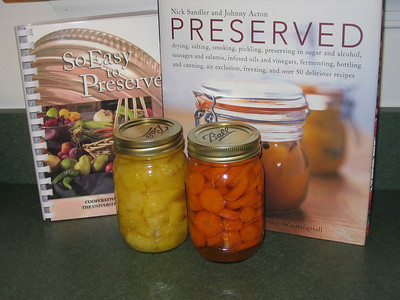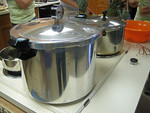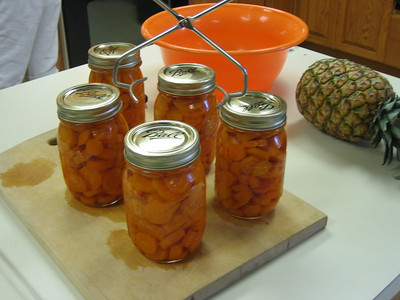Well, no, actually I don’t. I did, however, take a hands-on preserving class last week that taught me a bit about canning. Foremost, I discovered that I won’t be spending my summer afternoons hovering a steaming pressure canner in my equally steamy kitchen. Why not? In a word, equipment. I don’t own a pressure canner, a key tool in canning. I suspect that I won’t develop a passion for preserving that is worthy of the $70 to $325 investment in one, either.
Equally important and, truthfully, the primary reason, I learned just how exacting food preservation must be. Dole out one under-heated jar of green beans or expired bottle of garlic-infused oil and I’ve served my guests a lovely bowl of botulism. Thanks to my tainted meal, they can look forward to dry mouth, slurred speech, difficulty breathing, diarrhea and vomiting followed by respiratory failure, paralysis and death. A to-die-for dinner indeed.

In reality the likelihood of me poisoning my friends is quite slim. As long as I faithfully follow the recipes, which I am rarely wont to do, and keep my pressure canner gauge at 11 pounds, I can safely can. WooHoo!
If I were to delve further into this form of food preservation, I would choose water bath over pressure canning. Inexpensive water bath canners preserve highly acidic foods such as fruits and tomatoes. Want to make jellies, jams, marmalade or preserves? Buy a $25 canner, some jars, lids and fruit and you’re ready to go.
My predilection for sweets and tendency to be a cheapskate are not the only reasons that I prefer the water bath. Time is another. With a pressure canner you’re tied to the kitchen — and canner — for several hours. Steam has to build up then vent in a steady stream for 10 minutes before the actual pressure canning process can begin. That then takes anywhere from 25 to 90 minutes. With a water bath, you can process 7 or 8 jars of fruit in as little as 5 minutes. As patience is absolutely not one of my virtues . . ..
 In class we worked with high and low acid foods so used both types of equipment. Low acid foods such as vegetables and meats tend to carry botulism so must be preserved at a temperature of 240 degrees Fahrenheit. Hence why we employed a pressure canner for our jars of sliced carrots. With the lid locked in place, the canner cooked away for roughly 35 minutes. Once the cooker had cooled and the lid removed, we wound up with jars of beautiful, copper-colored carrot coins.
In class we worked with high and low acid foods so used both types of equipment. Low acid foods such as vegetables and meats tend to carry botulism so must be preserved at a temperature of 240 degrees Fahrenheit. Hence why we employed a pressure canner for our jars of sliced carrots. With the lid locked in place, the canner cooked away for roughly 35 minutes. Once the cooker had cooled and the lid removed, we wound up with jars of beautiful, copper-colored carrot coins.

Packed in juice, our acidic pineapple chunks boiled away in a 212 degrees Fahrenheit water bath. In 5 minutes or so the jars of sunny fruit were plucked from the bubbling water. Fifteen minutes later we strolled out of class with two jars of canned produce in our hands. Time definitely is on the side of water baths.
Sitting on my kitchen counter, the jars serve as a reminder of my brief foray into canning. Perhaps they’ll inspire me to preserve some tomatoes or can pickles. Then again, they probably will prompt more trips to the farmers’ markets where I can buy already canned goods!